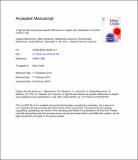Files in this item
A high fat diet induces sex-specific differences in hepatic lipid metabolism and nitrite/nitrate in rats
Item metadata
| dc.contributor.author | Stanimirovic, Julijana | |
| dc.contributor.author | Obradovic, Milan | |
| dc.contributor.author | Jovanovic, Aleksandra | |
| dc.contributor.author | Sudar-Milovanovic, Emina | |
| dc.contributor.author | Zafirovic, Sonja | |
| dc.contributor.author | Pitt, Samantha Jane | |
| dc.contributor.author | Stewart, Alan James | |
| dc.contributor.author | Isenovic, Esma R | |
| dc.date.accessioned | 2017-02-27T00:32:42Z | |
| dc.date.available | 2017-02-27T00:32:42Z | |
| dc.date.issued | 2016-04-01 | |
| dc.identifier | 241204300 | |
| dc.identifier | a68bdb4a-9378-4de3-bd4b-973c4de82dac | |
| dc.identifier | 84960354313 | |
| dc.identifier | 000373658000006 | |
| dc.identifier.citation | Stanimirovic , J , Obradovic , M , Jovanovic , A , Sudar-Milovanovic , E , Zafirovic , S , Pitt , S J , Stewart , A J & Isenovic , E R 2016 , ' A high fat diet induces sex-specific differences in hepatic lipid metabolism and nitrite/nitrate in rats ' , Nitric Oxide , vol. 54 , pp. 51-59 . https://doi.org/10.1016/j.niox.2016.02.007 | en |
| dc.identifier.issn | 1089-8603 | |
| dc.identifier.other | ORCID: /0000-0003-4580-1840/work/60195814 | |
| dc.identifier.other | ORCID: /0000-0003-2257-1595/work/60196235 | |
| dc.identifier.uri | https://hdl.handle.net/10023/10369 | |
| dc.description | This work is supported by the grants No.173033 and III41028 from the Ministry of Science, Republic of Serbia. | en |
| dc.description.abstract | Men and women differ substantially in regard to the severity of insulin resistance (IR) but the underlying mechanism(s) of how this occurs is poorly characterized. We investigated whether a high fat (HF) diet resulted in sex-specific differences in nitrite/nitrate production and lipid metabolism and whether these variances may contribute to altered obesity-induced IR. Male and female Wistar rats were fed a standard laboratory diet or a HF diet for 10 weeks. The level of plasma nitrite/nitrate, as well as free fatty acid (FFA), in both plasma and liver lysates were assessed. The levels of inducible nitric oxide (NO) synthase (iNOS), p65 subunit of NFκB, total and phosphorylated forms of Akt, mTOR and PDK-1 in lysates, and the levels of glucose transporter 2 (Glut-2) and fatty acid translocase/cluster of differentiation 36 (FAT/CD36) in plasma membrane fractions of liver were assessed. HF-fed male rats exhibited a significant increase in plasma nitrite/nitrate, and hepatic FFA and FAT/CD36 levels compared with controls. They also displayed a relative decrease in iNOS and Glut-2 levels in the liver. Phosphorylation of Akt (at Ser473 and Thr308), mTOR and PDK-1 was also reduced. HF-fed female rats exhibited increased levels of NFκB-p65 in liver compared with controls, while levels of Glut-2, FAT/CD36 and Akt phosphorylation at Thr308 and PDK-1 were decreased. Our results reveal that altered lipid and glucose metabolism in obesity, lead to altered iNOS expression and nitrite/nitrate production. It is likely that this mechanism contributes to sex-specific differences in the development of IR. | |
| dc.format.extent | 9 | |
| dc.format.extent | 1132740 | |
| dc.language.iso | eng | |
| dc.relation.ispartof | Nitric Oxide | en |
| dc.subject | High fat diet | en |
| dc.subject | Sex differences | en |
| dc.subject | Insulin resistance | en |
| dc.subject | Liver metabolism | en |
| dc.subject | Nitrite/nitrate | en |
| dc.subject | RM Therapeutics. Pharmacology | en |
| dc.subject | NDAS | en |
| dc.subject | SDG 3 - Good Health and Well-being | en |
| dc.subject.lcc | RM | en |
| dc.title | A high fat diet induces sex-specific differences in hepatic lipid metabolism and nitrite/nitrate in rats | en |
| dc.type | Journal article | en |
| dc.contributor.institution | University of St Andrews. School of Medicine | en |
| dc.contributor.institution | University of St Andrews. Institute of Behavioural and Neural Sciences | en |
| dc.contributor.institution | University of St Andrews. Biomedical Sciences Research Complex | en |
| dc.identifier.doi | 10.1016/j.niox.2016.02.007 | |
| dc.description.status | Peer reviewed | en |
| dc.date.embargoedUntil | 2017-02-26 |
This item appears in the following Collection(s)
Items in the St Andrews Research Repository are protected by copyright, with all rights reserved, unless otherwise indicated.

